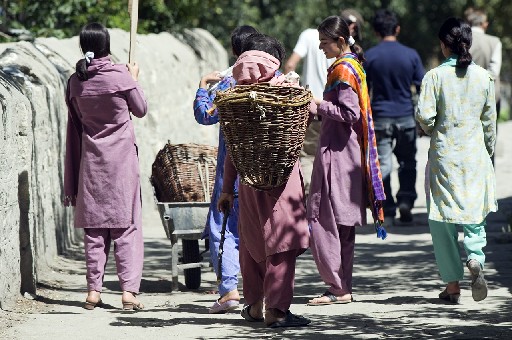|
 About
172 km west of Rawalpindi/Islamabad by road about half an hour by air lies
the last major town of Pakistan, the ancient
and legendary Peshawar,
city of proud Pathans. Peshawar the capital
city of North-West Frontier Province, is a
frontier town, the meeting place of the sub-continent and Central
Asia. It is also a place where ancient traditions jostle with
those of today, where the bazaar in the old city has changed little in the
past hundred years except to become the neighbour of a modern university,
some modern hotels, several international banks and one of the best museums
in Pakistan.No other city is quite like old Peshawar. The bazaar within the walls is
like an American Wild movie costumed as a Bible epic. Pathan tribesmen stroll
down the street with their hands hidden within their shawls, their faces half
obscured by the loose ends of their turbans. (With his piercing eyes and
finely chiseled nose, the Pathan must be the handsomest man on earth).The
fortunes of Peshawar at inextricable linked to
the Khyber Pass, the eastern end of which it
guards. The pass seems to have been little used in prehistoric times, and
even in early historic times it was generally shunned as too narrow and thus
too prone to ambush. Not until the powerful Kushans invaded Gandhara and
pacified the area in the first century AD did the Khyber become a popular
trade route. Peshawar
owes its founding 2,000 years ago to those same Kushans. In the second
century AD, Kanishka, the greatest of the Kushan kings, moved his winter capital
here from Pushkalavati, 30 kilometers (20 miles) to the north. His summer
capital was north of Kabul at Kapisa, and the
Kushans moved freely back and forth through the Khyber
Pass between the two cities, from which they ruled their
enormous and prosperous empire for the next 400 years. After the Kushan era, Peshawar declined into
an obscurity not broken until the 16th century, following the Mughal emperor
Babar's decision to rebuild the fort here in 1530. Sher Shah Suri, has
successor (or, rather, the usurper of his son's throne), turned Peshawar's
renaissance into a boom when he ran his Delhi-to-Kabul Shahi Road through the
Khyber Pass. The Mughals turned Peshawar
into a 'city of flowers' (one of the meanings of its name) by planting trees
and laying our gardens. In 1818, Ranjit Singh captured Peshawar for his Sikh Empire. He burned a
large part of the city and felled the trees shading its many gardens for
firewood. The following 30 years of Sikh rule saw the destruction of Peshawar's own Shalimar Gardens
and of Baba's magnificent fort, not to mention the dwindling of the city's
population by almost half. The British caused the Sikh's retreat and occupied
Peshawar in
1849 but, as much as Sikh rule had been hated, its British replacement
aroused little enthusiasm. About
172 km west of Rawalpindi/Islamabad by road about half an hour by air lies
the last major town of Pakistan, the ancient
and legendary Peshawar,
city of proud Pathans. Peshawar the capital
city of North-West Frontier Province, is a
frontier town, the meeting place of the sub-continent and Central
Asia. It is also a place where ancient traditions jostle with
those of today, where the bazaar in the old city has changed little in the
past hundred years except to become the neighbour of a modern university,
some modern hotels, several international banks and one of the best museums
in Pakistan.No other city is quite like old Peshawar. The bazaar within the walls is
like an American Wild movie costumed as a Bible epic. Pathan tribesmen stroll
down the street with their hands hidden within their shawls, their faces half
obscured by the loose ends of their turbans. (With his piercing eyes and
finely chiseled nose, the Pathan must be the handsomest man on earth).The
fortunes of Peshawar at inextricable linked to
the Khyber Pass, the eastern end of which it
guards. The pass seems to have been little used in prehistoric times, and
even in early historic times it was generally shunned as too narrow and thus
too prone to ambush. Not until the powerful Kushans invaded Gandhara and
pacified the area in the first century AD did the Khyber become a popular
trade route. Peshawar
owes its founding 2,000 years ago to those same Kushans. In the second
century AD, Kanishka, the greatest of the Kushan kings, moved his winter capital
here from Pushkalavati, 30 kilometers (20 miles) to the north. His summer
capital was north of Kabul at Kapisa, and the
Kushans moved freely back and forth through the Khyber
Pass between the two cities, from which they ruled their
enormous and prosperous empire for the next 400 years. After the Kushan era, Peshawar declined into
an obscurity not broken until the 16th century, following the Mughal emperor
Babar's decision to rebuild the fort here in 1530. Sher Shah Suri, has
successor (or, rather, the usurper of his son's throne), turned Peshawar's
renaissance into a boom when he ran his Delhi-to-Kabul Shahi Road through the
Khyber Pass. The Mughals turned Peshawar
into a 'city of flowers' (one of the meanings of its name) by planting trees
and laying our gardens. In 1818, Ranjit Singh captured Peshawar for his Sikh Empire. He burned a
large part of the city and felled the trees shading its many gardens for
firewood. The following 30 years of Sikh rule saw the destruction of Peshawar's own Shalimar Gardens
and of Baba's magnificent fort, not to mention the dwindling of the city's
population by almost half. The British caused the Sikh's retreat and occupied
Peshawar in
1849 but, as much as Sikh rule had been hated, its British replacement
aroused little enthusiasm.
|